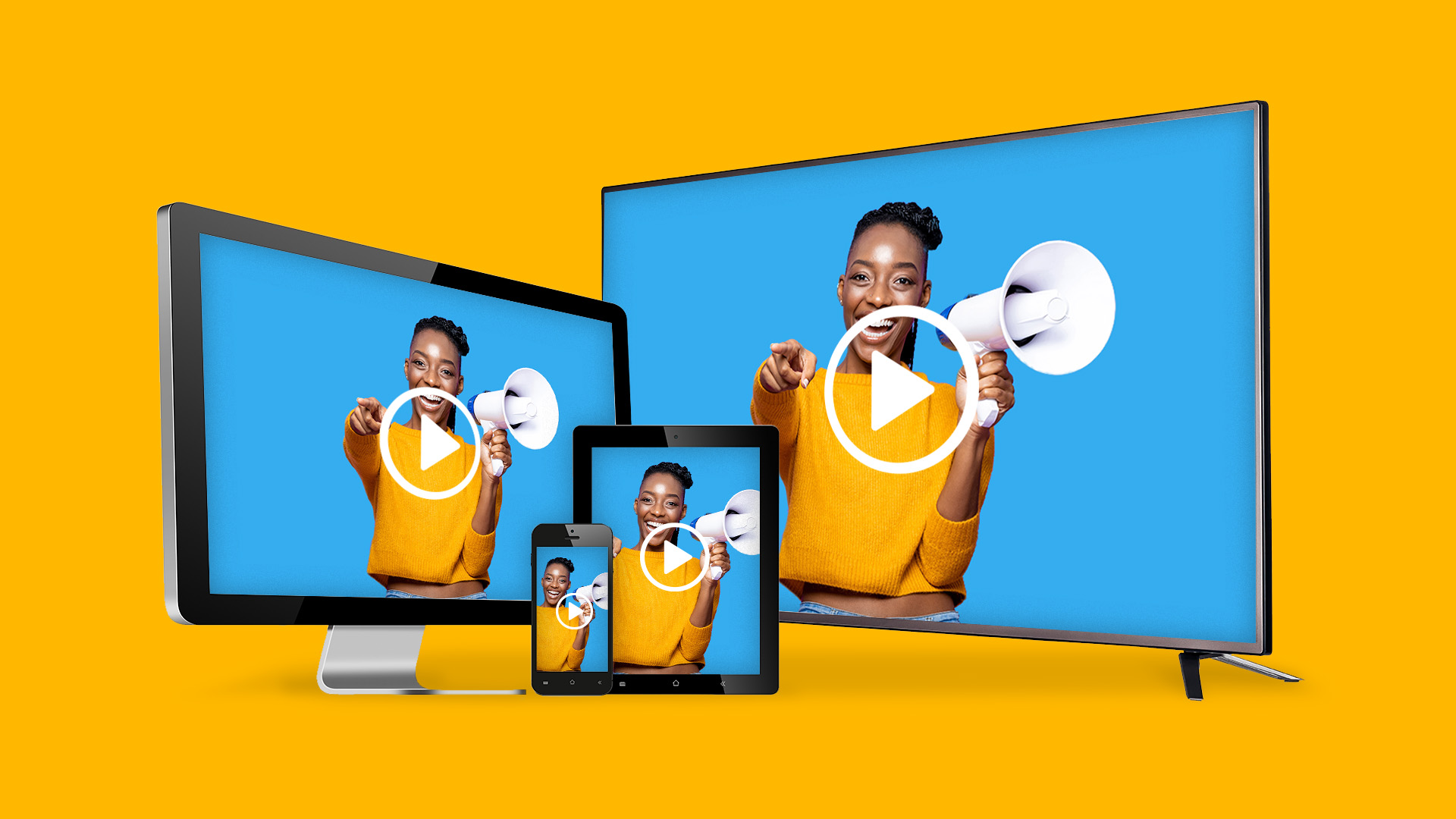Best Video Types for Advertising in 2024

With data privacy restrictions, new advertising platforms, an abundance of streaming services, virtual and augmented reality options, and so much more, there’s a lot to consider when it comes to advertising in 2024.
As industries, consumers, and technology advance, it’s increasingly essential to connect with your customers across several of their favorite platforms. Since video is leading the way in engagement, it’s time to reevaluate your video marketing strategy. Here, we’ll walk you through the best video types for advertising in 2024 (with some examples, of course).
- Explainer
- Product Spotlight
- Customer Testimonials
- Case Study Videos
- Culture
- Educational
- How-To
- Direct Response Social
- Brand Commercial
- Mini-Doc
1. Explainer
Explainer videos show your product what your product is and how it works. Whether live action or animation, the narratives within these videos often drive viewers to learn more about the brand and its products. Depending on what part of the funnel you are trying to target — and what channels your explainer video will live on — you can get incredibly granular with the information you include.
Explainers are one of the most popular B2B video marketing styles. Since these videos can effectively showcase intangible products — like SaaS or apps — your audience can gain more information about your products.
In this CBRE animated explainer video, the brand uses a common (and effective) formula for this video type. They start out by focusing directly on the problem your customer faces. Then, once the viewer is hooked, they deliberately highlight their brand’s service as the solution.
2. Product Spotlight
A product spotlight video makes your product the hero of the story. These versatile videos can introduce a product, grow awareness, and move prospects further down the funnel. With many different options, you can create a cost-effective video production process, including through motion graphics.
A product spotlight video can be educational, taking on a narrative to demonstrate your product’s utility. Or you can create a short, eye-catching video to help your product stand out in a bustling content landscape. No matter the direction you choose to take, make sure you highlight key value propositions and showcase your product in the best light possible.
In this Bombas ad, they use a quick animation to highlight the product and three of its value propositions. This video is perfect for an informational social media campaign or a product video on the brand’s website.
3. Customer Testimonials
Customer testimonial videos create a narrative with a single individual or a small group of people talking about their experiences with your product. You can use these types of videos to communicate a story with a people-first narrative. These videos can be extremely effective in helping your audiences visualize the personal benefits of your product offering or understanding how it might fit into their lives.
One popular way to present customer testimonials is through user-generated content (UGC). Today, however, many of these videos are created by brands, also known as UGC-style content. These videos are similar to organic UGC videos, however they (often) use actors, a production team, and a script. UGC-style content allows brands to strike an instant connection with audiences — likely because audiences are familiar with friends, family, and influencers speaking about brands and products on social media. Since this content mimics the style of organic UGC, viewers are seeing relatable and familiar video formats.
In addition to UGC-style, there are many different types of customer testimonials. Another example is this Forward testimonial, which walks viewers through the process of using the product. From receiving the kit to accessing additional resources later in the process, each step is explained, which can help viewers begin to trust the product.
4. Case Study Videos
We briefly mentioned it above, but creating trust in your brand is essential. Of course you know your business best, but customer stories can help grow social proof, which is incredibly influential for potential customers. And that’s where case study videos come into play!
Similar to a B2C customer testimonial video, case study videos allow your clients to give first-hand accounts of the success they achieved working with your brand. Essentially, you’ll want to use these videos to validate your product and drive confidence in your brand.
By empowering your clients to tell their story as it relates to your brand, you can establish a deeper level of credibility with your audiences. If you have clients across multiple audience segments (and we’re guessing you do!), make sure you have a unique case study video for each of them. With relatable content and real use cases, prospective clients will be more likely to connect with your video ads and convert more efficiently.
In this Square case study video, the video is told from the business owner’s perspective, giving full context to the situation. Throughout, he explains how his business used Square’s products and services to maintain and grow their business through an incredibly complex time.
5. Culture Videos
Culture videos can be an effective way to highlight your brand’s values and showcase your team’s culture. This video type can be used for marketing purposes, employee recruitment, and to express your brand’s commitment to diversity, equity, and inclusion.
By using QuickFrame, Cruise was able to create a video focused on their internship program. From an audience’s perspective, looking at the business culture from the viewers’ perspective can make the brand feel more honest, trustworthy, and accessible. By focusing on the employees, Cruise humanizes their brand and creates more relatable video content.
6. Educational
Educational video content allows your brand to stand out as thought leaders in your industry, building authority while you promote your products.
While audience segments are critical throughout your video marketing strategy, they’re especially important when it comes to educational content. If you’re trying to educate a general audience that is likely unaware of your brand, you can keep the educational content broad as well. But if you’re using precision audience targeting to connect with your existing customers, you’ll want to dive a little deeper into your industry and tell them something they may not know.
In this Colgate video, they are sharing information about cavities. This is a great message for people who may not know much about dental health or are looking to buy a new toothpaste. Throughout the video, Colgate makes sure their logo is visible on the screen. When their audience remembers the educational video, they want them to remember the brand that aired it, too.
7. How-To
A how-to video is an effective way to give your audience step-by-step instructions on how to use your product. You can also use how-to videos to address common customer questions, offer alternative use cases, and more. While many B2C brands will use live action how-to videos, animated ads can also be effective for software or other non-tangible products and services.
While these can be effective throughout the sales funnel for brick-and-mortar and ecommerce brands, they’re particularly helpful during the consideration stage, especially if your product’s utility is more complex than the average offering.
In this Not Your Mother’s ad, the brand explains how to use the product in just 15 seconds. With on-screen text and visuals for clarity, viewers can walk away with more information about the product than they might have had before, helping them move throughout the sales process.
8. Direct Response Social
Today, social media video content is essential for reaching your target audience. Often created with specific platforms and performance marketing plans in mind, these direct-response social videos offer a clear CTA to spur action and are designed to get audiences to act.
Since these videos are made for specific platforms, they’re each designed to appear native on the platform. For example, a Facebook video would be created differently than a TikTok video so each can feel like it belongs on the platform. Aside from TikTok, many of these videos are primarily designed for a sound-off experience, so you might notice more on-screen text than other video types.
In this DoorDash ad crafted for TikTok, the on-screen text tells the most important information while the audio rounds out the storyline.
9. Brand Commercial
When you think of video ads, brand commercials are likely what first comes to mind. You might think of a certain kind of horse during a specific sporting event or a funny pizza ad that just happens to air during your family TV time in the evenings.
The brand commercial is the most traditional type of marketing video production and dates back all the way to July 1, 1941, when Bulova aired the first TV commercial ever — it was just 10 seconds long and cost $9 to run.
Today, brand commercials obviously look much more elevated, can run on so many different platforms beyond TV, and definitely cost more to produce and run. Commercials are great for shining a spotlight on your brand. You can express the value you offer the world while growing awareness and increasing the favorability of your brand.
This Native ad uses a unique situation and the perfect actor (seriously, I would have broken character so fast) to advertise their products. With a fun premise and some relevant props, this ad hooks (you’ll get this pun once you watch the ad) viewers into watching the entire video.
10. Mini-Documentary
Last but not least: the mini-documentary (or mini-doc, when the industry gets tired of writing the full name). This video type is exactly what it sounds like — a mini-documentary that combines interviews and b-roll footage to tell an engaging story. This is a more subtle way to tell a person-first narrative while sharing your brand values, building awareness, and discussing relevant topics.
In this Outer mini-doc, the brand’s CEO spends time discussing the mission of the brand in a few different ways. Through this information, viewers can get a better insight into the company, creating a deeper (and often emotional) connection.
Do More with Video
Learn how we can help you produce more quality videos affordably and at scale.


